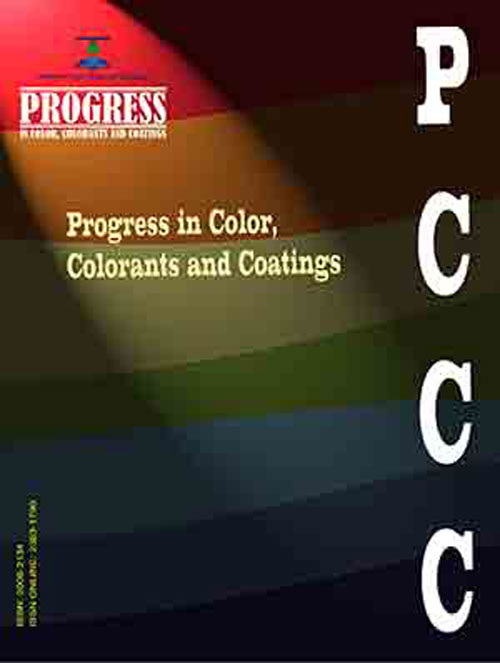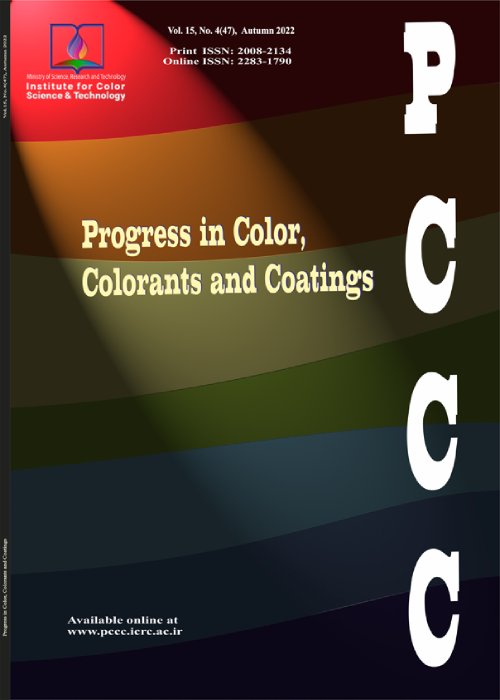فهرست مطالب

Progress in Color, Colorants and Coatings
Volume:9 Issue: 4, Autumn 2016
- تاریخ انتشار: 1395/10/13
- تعداد عناوین: 7
-
-
Editorial BroadPage 1
-
Page 223In this paper, polymer-based nanocomposites powder were applied on the surface of plain carbon steel by electrostatic device and then were cured by microwave. The effect of adding nanoparticles on the corrosion resistance properties of the coatings was investigated by Electrochemical Impedance Spectroscopy and immersion test in 3.5 NaCl solution. Coatings structure and morphology of nanoparticles were investigated by scanning electron microscopy and transmission electron microscopy. The results of Electrochemical Impedance Spectroscopy and immersion test show that the corrosion resistance of the coating is increased significantly more than 10 time, by adding nanoclay because of barrier properties of nanoparticles. Also Embedding Nanoparticles in polyester coating fabricated a denser coatings, more uniform and less pores in comparison with the pure polyester coatings. Surface roughness of coated samples were showed more roughness for nanocomposite coatings.Keywords: EIS, Electrostatic, Nanocomposite, Nanoclay, Immersion test
-
Page 233Zn-Al layered double hydroxide (LDH) nanoparticles with carbonate as the charge balancing anion in the interlayer space were synthesized using co-precipitation method. Then, the carbonate base Zn-Al LDH nanoparticles were doped with phosphate ion via anion-exchange reaction to synthesize Zn-Al-[PO43-]-[CO32-]. The structure and composition were characterized by X-ray diffraction (XRD), Fourier transform infrared spectroscopy (FT-IR) and thermal gravimetric-differential thermal analysis (TG-DTA). Inductively coupled plasma-optical emission spectrometer (ICP-OES) was employed to measure the phosphate release ability of Zn-Al-[PO43-]-[CO32-] in the 3.5 wt% NaCl solution. Results showed that zinc cation can release along with phosphate anion during ion exchange process. Then, the corrosion inhibition of phosphate anion and zinc cation on mild steel specimens was assessed by electrochemical impedance spectroscopy (EIS) and polarization. Field emission-scanning electron microscopy (FE-SEM) was used to study the surface morphology of the mild steel specimens after exposure to the test solutions. The results indicated the significant impact of zinc and phosphorus concentration in test solution on the corrosion inhibition properties. Prog. Color Colorants Coat. 9 (2016), 231-246© Institute for Color Science and Technology.Keywords: Layered double hydroxide, Ion exchange, Phosphate, Corrosion inhibition
-
Page 249Titanium dioxide nanoparticles surface-modified by 5-sulfosalicylic acid 5-SA-TiO2 were prepared in ethanol by the chemisorption process. The effects of surface improvement on the photocatalytic degradation and adsorption of methyl orange MO were studied in a batch system by considering the various parameters, such as contact time, adsorbent dosage, pH, initial dye concentration and temperature. The adsorption and photocatalytic degradation kinetics of MO using the improved nanoparticles have also been investigated. The results show that the adsorption and photocatalytic degradation processes were good fit with the pseudo-second-order kinetic model R2 0.99. In addition, the equilibrium data for the adsorption process have been evaluated using Langmuir, Freundlich and Temkin isotherms. The adsorption isotherm of MO onto modified TiO2 nanoparticles fitted into the Temkin equation.Keywords: Methyl Orange, TiO2 nanoparticles, Surface, modification, 5, Sulfosalicylic acid
-
Page 261In this paper, synthesis and antimicrobial properties of cationic dye were investigated. 4-acetylamino-N-2-aminomethylpyridine-1,8-naphthalimide was reacted with 1-bromobutane as the alkylating agent and a cationic dye was obtained. The final product was purified by column chromatography method. The chemical structure of the novel cationic dye and its intermediates was chracterisized by using FTIR, 1HNMR, 13CNMR and DSC techniques. The antimicrobial efficacy of the dye was evaluated by using a minimum inhibitory cocentration MIC and disk difusion methods. The synthesized dye and its intermediates showed good antimicrobial activities against both Gram positive and Gram negative bacteria. Also, the results indicated that cationic dye 3 containing 1-bromobutane as the alkylating agent had highest antimicrobial activity against all the bacteria used.The MIC of the novel cationic dye against E. coli was 125 μg ml−1 and S.aureus was 62.5 μg ml−1.Keywords: Cationic dye, Naphthalimide, Antimicrobial agent, Synthesis, Aminomethylpyridine
-
Page 269In this study, stable lattices of terpolymer butyl acrylate, methyl methacrylate, and styrene were synthesized by a mini-emulsion polymerization technique using tert-butyl hydroperoxide TBHP/Fe2 /ethylenediaminetetraacetic acid/sodium formaldehyde sulfoxylate redox initiators at room temperature, and the kinetics of the reaction were studied. The reaction rate was obtained from periodic sampling. The chemical compositions of the samples were identified by FTIR. The distribution index of some polymers and their distribution were determined by gel permeation chromatography. The size distribution of the polymers in the lattices was obtained by dynamic light scattering. From the results of the DSC test, it was deduced that copolymerization produces a structure of special blocks and that this particular terpolymer has two glass-transition temperatures.Keywords: acrylic resins, mini, emulsion polymerization, copolymerization, redox initiator systems, glass, transition temperature
-
Page 281Chromium carbide nickel chromium powder Cr3C2-25wt.NiCr was plasma sprayed by a water-stabilized system WSP®. A series of experiments with variable feeding distance was carried out. Basic characterization of coatings was done by XRD, SEM and light microscopy plus image analysis. Microhardness was measured on polished cross sections. The main focus of investigation was on resistances against wear in dry as well as wet conditions. The appropriate tests were performed with set-ups based on ASTM G65 and G75, respectively. The influence of spray parameters onto coating wear performance was observed. The results of mechanical tests are discussed in connection with changes in the character of the coatings microstructure. The results show that for obtaining the best possible Cr3C2-25NiCr coating with WSP® process, from the viewpoint of wear resistance, medium feeding distance is desired and its decrease or increase leads to certain worsening of studied properties.Keywords: Plasma spraying, Chromium carbide, Slurry abrasion, Dry rubber wheel test, Friction, Microhardness


